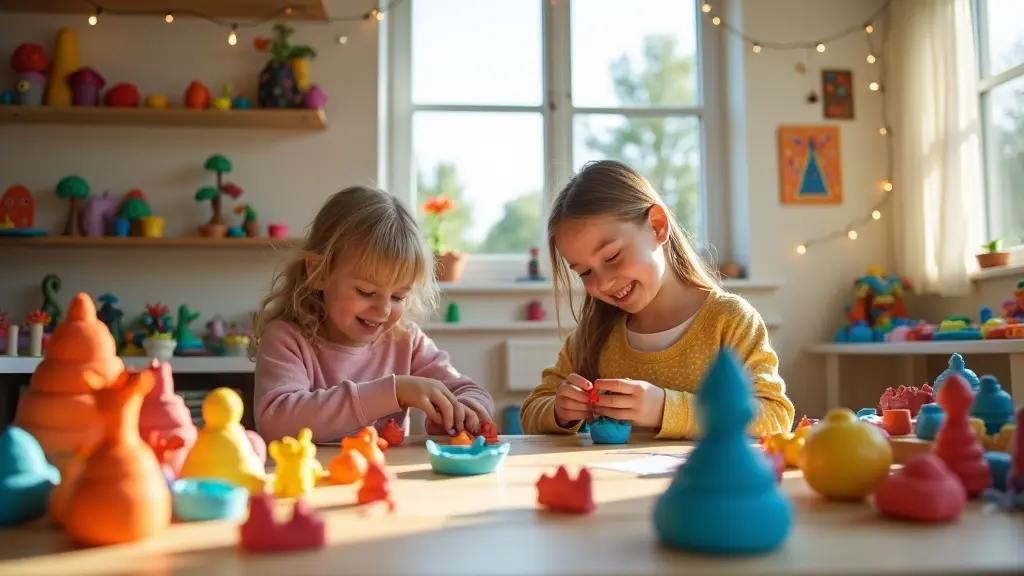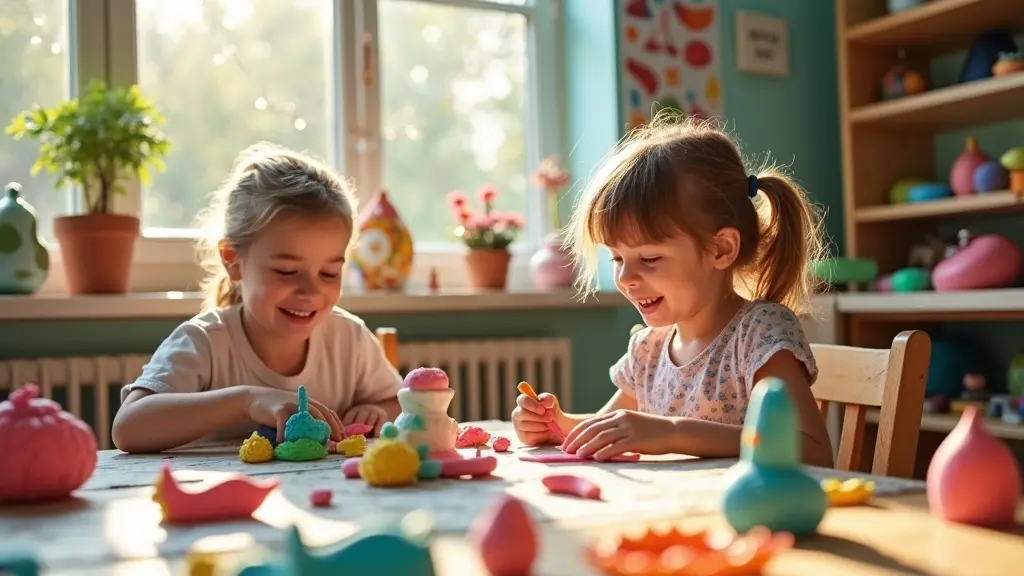Kids Clay Projects Spark Imagination And Joy

Developing a creative outlet for children is vital for their emotional and cognitive development, and a most effective way to do so is by allowing them to express themselves through tactile learning experiences.
Fostered creativity sparks imagination, helping kids develop problem-solving skills and self-confidence.
Hands-on art projects, such as sculpting, provide an outlet for self-expression, reducing stress and anxiety in children.
By engaging in fun and artistic expression activities, kids learn critical thinking and collaboration skills.
Pottery activities, for instance, perfect for introducing children to the world of art and craftsmanship, offer a unique opportunity for kids to explore their creativity. These tactile learning experiences not only develop fine motor skills but also encourage children to think critically and solve problems by engaging in activities like modeling, sculpting, pottery, and artistic expression.
Getting Started With Clay Modeling
Discover the Joy of Creative Expression Unleashing your imagination through handmade, hands-on activities can be a remarkable way to tap into your inner creative genius. Getting started with clay modeling can be an incredibly rewarding experience, not just for kids but also for adults looking to revitalize their craft time and create something truly unique.

Why Choose Clay For Kids?
Clay has been a timeless, versatile medium that has captivated children’s imagination for centuries. Pinch pots, coil building, and slab construction are just a few techniques that encourage creativity and self-expression in young minds.
In today’s digital age, it’s essential to strike a balance between screen time and hands-on experiences that foster cognitive, motor, and emotional growth.
Engaging children in creative activities like clay modeling offers a unique opportunity for holistic development.
By working with airdry clay or polymer clay, kids develop their fine motor skills, hand-eye coordination, and problem-solving abilities. As they explore the tactile world of clay, they also enhance their emotional intelligence and self-confidence.
Enhancing Cognitive Development
Understanding spatial awareness and geometry through clay modeling is a critical cognitive skill that kids develop. By manipulating clay, children practice problem-solving skills and develop their fine motor skills and creativity.
Benefits of Clay Modeling for Children
- Clay modeling has been a popular activity for children for centuries, with various techniques such as pinch pots, coil building, and slab construction.
- Engaging in clay modeling activities can help children develop their fine motor skills, hand-eye coordination, and problem-solving abilities.
- Working with clay can also enhance children’s emotional intelligence and self-confidence, as they explore the tactile world of clay.
- Understanding spatial awareness and geometry through clay modeling is a critical cognitive skill that kids develop, as they practice problem-solving skills and creativity.
Exploring Tactile Learning Through Clay
The underrated art of touch. While our brains are wired to. process information through visual and auditory means, our sense of touch plays a vital role in shaping our understanding of the world.
In fact, research suggests that children who engage in tactile activities, such as playdough alternatives, exhibit improved cognitive, social, and emotional development.
Tactile learning refers to the process of learning through touch and exploration.
It’s an essential aspect of childhood development, allowing children to understand and interpret the world around them. Clay, in particular, is an ideal medium for tactile learning due to its malleable and manipulable nature, making it an excellent tool for creative workshops.
How Clay Enhances Tactile Learning
———————————
Clay’s unique properties make it an excellent tool for tactile learning. Children can shape, mold, and manipulate clay to stimulate their sense of touch and develop their artistic skills in a variety of art class, creative workshops, playdough alternatives, kilnfired projects, glazing techniques, texture exploration.
Fun Pottery Projects For Children
Nurturing creativity in children is essential for their overall development, and one of the most effective ways to do so is through engaging hands-on activities that stimulate their artistic development.
Why Pottery is a Valuable Skill for Children
Pottery projects are an excellent way to develop fine motor skills in children, which are essential for hand-eye coordination and dexterity.
Strong fine motor skills also lay the foundation for future academic success.
Benefits of Engaging in Creative Activities
Creative activities like pottery projects also enhance spatial awareness, allowing children to better understand and manipulate objects in 3D art space.
This skill is crucial for problem-solving and critical thinking. Helps develop 3D art, fine motor skills, and artistic development while allowing for self-expression and messy fun through DIY crafts.
Unleashing Imagination With Sculpting Techniques
Sculpting has the power to unlock a child’s full creative potential, allowing them to explore and express themselves in a unique and innovative way.
Sculpting techniques have a profound impact on a child’s cognitive development, fostering creative thinking and problem-solving skills.
The benefits of sculpting extend beyond mere creativity, as it also develops fine motor skills, hand-eye coordination, and spatial awareness.
Sculpting has been recognized as a valuable tool in art therapy, providing an outlet for children to express emotions and work through challenging situations.
Incorporating sculpting into collaborative projects can also promote family bonding and social skills, as children learn to work together and share ideas. As an educational play tool, sculpting techniques can be integrated into STEAM activities, encouraging children to think critically and creatively.
Developing Fine Motor Skills, which also fosters creativity, problem-solving, and bonding through art therapy, collaborative projects, family bonding, educational play, and STEAM activities.
How Does Clay Boost Creativity?
Creativity is a vital component of children’s development, enabling them to think outside the box, solve problems, and express themselves effectively. Unfortunately, research suggests that children’s natural creativity begins to decline sharply around the age of six, largely due to the emphasis on standardized testing and structured learning.
This decline is concerning, as creativity is essential for fostering artistic confidence and supporting children’s overall cognitive development.
Fortunately, there is a simple and effective way to combat this decline: introducing nontoxic clay into children’s lives.
Research has shown that tactile activities like clay manipulation stimulate the brain’s creative centers, enhancing cognitive function and boosting problem-solving skills.
In fact, a study published in the Journal of Art and Design Education found that children who participated in clay modeling activities demonstrated significant improvements in their spatial awareness, fine motor skills, and creative process. The use of childfriendly materials like clay helps to build artistic confidence and encourages children to engage in a more enjoyable and creative process.
Messy Fun And Artistic Expression
The earliest years of childhood are marked by an explosion of creative energy, as young minds begin to explore and express themselves through art, imagination, and play.
Messy Fun And Artistic Expression
One of the most effective ways to tap into this creative potential is through messy fun and artistic expression.
For example, crafting fantasy creatures with homemade clay or designing personalized gifts with paint and glitter can help develop fine motor skills and encourage children to think outside the box.
The benefits of unstructured play in fostering imagination and creativity cannot be overstated.
When children are given the freedom to explore and create, they are able to develop their problem-solving skills, build confidence, and think creatively. The Power of Unstructured Play
When we provide our children with the opportunity to engage in messy activities, such as creating decorative items with miniature sculptures, clay animals, fantasy creatures, personalized gifts, holiday ornaments, decorative items, they develop their creativity and problem-solving skills.
Developing Skills Through Handson Activities
Children’s minds are wired to absorb and process information through hands-on experiences. By engaging in creative play, they are exposed to a world of possibilities, where imagination knows no boundaries.
By artistic experimentation, they become acutely attuned to the sensory stimulation that fosters creativity and innovative thinking.
Artistic experimentation becomes a natural extension of their curiosity, inspiring them to explore new possibilities with confidence.
As they work through different projects, they begin to develop artistic pride in their accomplishments, a sense of ownership that builds confidence and self-assurance. This confidence boost is essential for future artistic endeavors and can be observed in their increasing willingness to take creative risks.
With hands-on activities, children develop problem-solving skills, critical thinking, and an understanding of how their ideas can take shape. By embracing creative freedom, they learn to express themselves authentically, and it’s beautifully showcased in the art display.
Creative Play
- Children’s brains are 20-30% more active during creative play, fostering neural connections and cognitive development.
- Hands-on activities can improve problem-solving skills by up to 50% in children aged 3-5 years old.
- Children who engage in creative play have a 25% higher chance of developing critical thinking skills and creativity in later life.
- Artistic experimentation can increase children’s confidence by up to 40% when they see their work displayed and receive positive feedback.
Seasonal Pottery Projects Spark Creative Joy
Pottery Tools Spark Creative Joy In Clay Art



